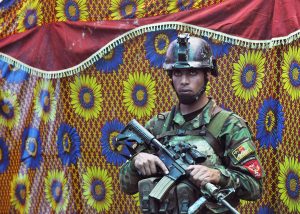U.S. President Joe Biden’s announcement of the withdrawal of U.S. forces from Afghanistan by September means the country has to brace for its future earlier than anticipated. The Afghan National Defense and Security Forces (ANDSF) are restructuring, while concerns are being raised about the future of Afghan women and how the country will maintain its economy and infrastructure without direct oversight. Even the prisoners in Guantanamo Bay see a ray of hope for their release. And yet, Afghanistan’s warlords are in many ways preparing for bloodshed and the return to the kind of inter-faction competition that occurred between 1992 and 1996 after the Soviet withdrawal from the country.
It is hard to predict whether a peace settlement will be reached or a protracted conflict will play out, but in the case of mass violence, Afghanistan’s near-term scenarios are limited. The international community is aware of the fragility of the Afghan state and the time needed to rebuild it, thus shifting its immediate focus to the ANDSF, which has fought alongside NATO over the past two decades and will be the country’s first line of defense after the U.S. leaves.
Last October, the ANDSF numbered 305,021 personnel, its highest in recent years. But even after receiving a total of 1,383 Humvees, 55 Mobile Strike Force vehicles, 10 Black Hawk helicopters, and four fixed-wing A-29 light-attack planes from Washington, it is still operationally weak. Many have pointed to a lack of coordination and overall inability to use resources efficiently. The latest quarterly report from the Special Inspector General for Afghanistan Reconstruction (SIGAR) shows a normal rate of attrition at 2 percent, but that too is expected to increase due to a drop in morale.
If the security situation deteriorates, many of the country’s former warlords may rush to protect their communities in an echo of the civil war era. Distrust in Kabul’s ability to protect the population is widespread, and all the more so for Afghan minorities. Recently, Abdul Ghani Alipoor, a Hazara militia commander, took up arms in the central provinces after his community was said to have been repeatedly attacked by Kuchis, a nomad community, and the Taliban. However, in an odd yet familiar twist, he faced heat from President Ashraf Ghani in March, when militias under his command in Behsud, Maidan Wardak, took down an Afghan helicopter.
Such incidents are neither rare, nor do they invite confidence about the allegiances of these strongmen. Both Ismail Khan and Gulbuddin Hekmatyar, veterans of the resistance against Soviet Union, the civil war, and the post-9/11 fight against the Taliban, recently held rallies in which hundreds of armed men marched through Badakhshan on April 18 and Herat on April 13. Hekmatyar’s party touted that his forces secured the Baharak district against the Taliban in the absence of protection from the government. Khan, too, at his rally, proclaimed that he wanted “real peace,” urging the Taliban to come to a peace settlement, but also said that if there wasn’t one, he would defend his people’s “honor and dignity.” Khan described the government as “incompetent” and then warned against any “reaction(s)” against his “mujahideen.” A mujahid in Islamic theology is someone who performs jihad, in this case, referring to the lesser but violent form of jihad. The symbolism also invokes memories of the Afghan jihad against the Soviets in the 1980s, who were deemed imperialistic and atheistic.
Framing a future resistance against the government or the Taliban as such is an ominous sign. It projects Ghani’s government as not only corrupt and incompetent, but also un-Islamic, further undermining its already weak legitimacy. This is important because the same calls to jihad, and allegations that the government is corrupt and a puppet of the West, are precisely what the Taliban claim as well.
But will an antagonistic approach work?
This will be determined by how Kabul engages the warlords. Ghani has previously mainstreamed warlords and currently has some of them allied with him and the government. Moving forward, he can also prevent a possible ethnicization of the ANDSF if the warlords fight alongside the army and are given positions in the government. However, while this approach might be effective against the Taliban, it can also add opportunities for such strongmen to fill their coffers. Kabul will also have to turn a blind eye to their history of human rights abuses. More pressingly, Ghani will certainly not forget the rampant side-switching carried out by the same outfits – all of which sided with the Taliban at least once – during the civil war.
Whatever happens, the history of warlordism within and outside of Afghanistan tells us that they are inherently volatile actors. Nonetheless, they will be playing a crucial role in the future if the government in Kabul has no better options.
































